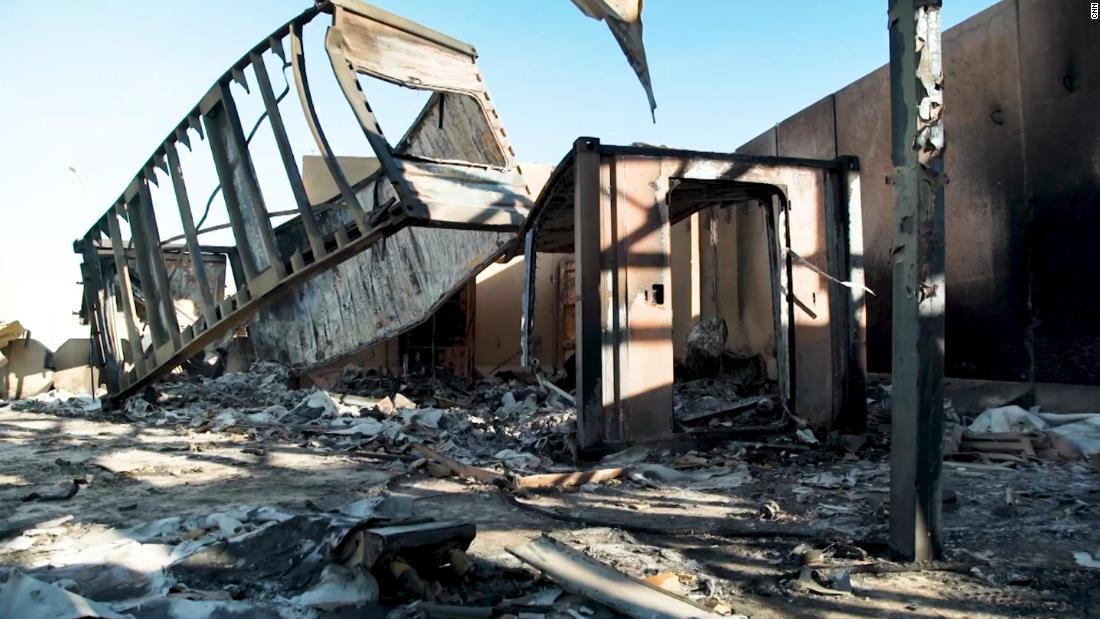
"While no U.S. service members were killed in the Jan. 8 Iranian attack on Al Asad Air base, several were treated for concussion symptoms from the blast and are still being assessed," the US-led military coalition fighting ISIS in Iraq and Syria said in a statement Thursday.
"Out of an abundance of caution, service members were transported from Al Asad Air Base, Iraq to Landstuhl Regional Medical Center in Germany for follow-on screening. When deemed fit for duty, the service members are expected to return to Iraq following screening," the statement added.
Concussions are not always apparent immediately after they've been suffered, but the disclosure indicates that the impact of the attack was more serious than initial assessments indicated. The attack, launched in retaliation for the US airstrikes that had killed Iranian Gen. Qasem Soleimani, significantly ratcheted up tensions between Iran and the US, though the prospect of further military confrontation appears to have abated for now.
A US military official told CNN that 11 service members had been injured in the attack, which was first reported by Defense One. Following the attack, the Pentagon had initially said that no casualties had resulted from the 16 missiles fired by Iran. The US military defines a casualty as either an injury or fatality involving personnel.
Asked about the apparent discrepancy, a Defense official told CNN, "That was the commander's assessment at the time. Symptoms emerged days after the fact, and they were treated out of an abundance of caution."
After this story published, Capt. Bill Urban -- the spokesperson for US Central Command, which oversees troops in the Middle East -- said the military had learned after the attack that 11 individuals were injured -- eight were transported to Landstuhl Regional Medical Center in Germany and three were sent to Camp Arifjan in Kuwait for "follow-on screening."
"As a standard procedure, all personnel in the vicinity of a blast are screened for traumatic brain injury, and if deemed appropriate are transported to a higher level of care," Urban said in a statement. "All soldiers in the immediate blast area were screened and assessed per standard procedure, according to the Defense Department. ... When deemed fit for duty, the service members are expected to return to Iraq following screening."
A US military spokesman in Baghdad explained to CNN's Arwa Damon that the service members were medevaced to Kuwait and Germany because those facilities had the necessary equipment to diagnose the brain injuries.
Official US reports about the attack have shifted since it occurred.
Last week, Secretary of Defense Mark Esper had said the initial assessment found only damage to property.
"The current (Battle Damage Assessment) is, if you will, again, we can get you details, things like tentage, taxiways, the parking lot, a damaged helicopter, things like that; nothing that I would describe as major, at least as I note at this point in time. So that's the state of -- of the attack at this point as we know it. Most importantly, no casualties, no friendly casualties, whether they are US, coalition, contractor, etc.," Esper said.
US officials also have offered differing accounts of what they see as the motivations behind Iran's attack. Vice President Mike Pence said last week that the administration believes the strikes "were intended to kill Americans," and Army Gen. Mark Milley, the chairman of the Joint Chiefs of Staff, said he believed that the attacks "were intended to cause structural damage, destroy vehicles and equipment and aircraft, and to kill personnel."
But a growing belief emerged among administration officials last week that Iran had deliberately missed areas populated by Americans. Multiple administration officials told CNN that Iran could have directed its missiles to areas populated by Americans, but intentionally did not. And those officials said Iran may have chosen to send a message rather than take action significant enough to provoke a substantial US military response, a possible signal the Trump administration was looking for a rationale to calm the tensions.
Iraq did receive a warning that the strike was coming and was able to take "necessary precautions," according to a statement from Iraq's Prime Minister Adil Abdul Mahdi. A US defense official said that Iraq, in turn, warned the United States.
However, Pentagon officials have said they received no such warnings from the Iraqis but that the US was able to detect the attack in enough time to alert US forces on the ground.
Iran's UN ambassador said last Friday that the Iraqi bases housing US troops had been primarily selected to demonstrate target accuracy, not to kill Americans, disputing public claims made by top Trump administration officials.
"We said before we took our military action that we would choose the timing and the place, and we chose the place where the attack against Soleimani was initiated," Ambassador Majid Takht Ravanchi told CNN's John Berman on "New Day" last Friday when asked about Pence's comments. "And we do not consider a high number of casualties as an instrumental element in our calculations."
Earlier this week, the Trump administration abruptly canceled four classified congressional briefings related to the ongoing Iran crisis, in some cases providing little or no explanation for doing so.
UPDATE: This story has been updated with additional information on the attack and a statement from US Central Command.
https://news.google.com/__i/rss/rd/articles/CBMiVmh0dHBzOi8vd3d3LmNubi5jb20vMjAyMC8wMS8xNi9wb2xpdGljcy9zZXJ2aWNlLW1lbWJlcnMtaW5qdXJlZC1pcmFuLXN0cmlrZS9pbmRleC5odG1s0gFaaHR0cHM6Ly9hbXAuY25uLmNvbS9jbm4vMjAyMC8wMS8xNi9wb2xpdGljcy9zZXJ2aWNlLW1lbWJlcnMtaW5qdXJlZC1pcmFuLXN0cmlrZS9pbmRleC5odG1s?oc=5
2020-01-17 13:11:00Z
52780557473351
Tidak ada komentar:
Posting Komentar